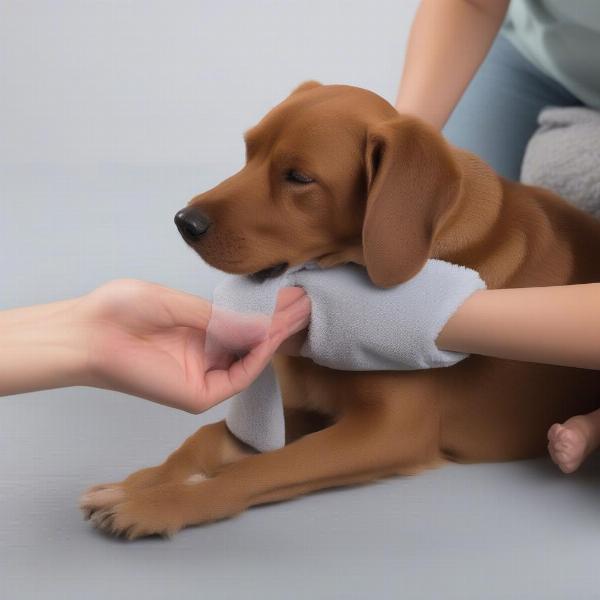A dog dislocated toe can be a painful and concerning injury for both the dog and its owner. Knowing how to identify, manage, and prevent this issue is crucial for every dog owner. This comprehensive guide will provide you with the information you need to navigate this situation, from recognizing the symptoms to understanding treatment options and long-term care.
Recognizing a Dislocated Toe in Your Dog
A dislocated toe occurs when the bones of the toe are displaced from their normal position in the joint. It can be caused by trauma, such as a fall or being stepped on, or by underlying conditions like arthritis. Recognizing the signs early is vital. Your dog may exhibit the following symptoms:
- Lameness or limping: This is often the first noticeable sign.
- Swelling: The affected toe will likely appear swollen and inflamed.
- Pain: Your dog may yelp or whimper when the toe is touched.
- Unusual positioning: The toe may appear bent at an odd angle or out of place.
- Reluctance to bear weight: Your dog may avoid putting weight on the affected paw.
First Aid and Veterinary Care for a Dislocated Toe
 Applying first aid to a dog's dislocated toe
Applying first aid to a dog's dislocated toe
If you suspect your dog has dislocated a toe, it’s crucial to seek veterinary care immediately. Do not attempt to reposition the toe yourself, as this can worsen the injury. As a first aid measure, you can apply a cold compress wrapped in a towel to the affected area to help reduce swelling and pain. Transport your dog to the vet as carefully as possible, minimizing movement of the injured paw.
Veterinary Diagnosis and Treatment Options
The veterinarian will perform a physical examination and may take X-rays to confirm the diagnosis and assess the severity of the dislocation. Treatment options vary depending on the specific case and can include:
- Manual reduction: The vet may be able to manipulate the bones back into place under sedation or anesthesia.
- Splinting or bandaging: Immobilizing the toe can help it heal properly.
- Surgery: In severe cases, surgery may be necessary to repair damaged ligaments or tendons.
- Pain medication: Your vet will likely prescribe pain medication to manage your dog’s discomfort.
Recovery and Long-Term Care
Following treatment, it’s essential to follow your veterinarian’s instructions carefully to ensure proper healing. This may include:
- Restricting activity: Limiting your dog’s movement can prevent re-injury.
- Administering medication: Ensure your dog receives prescribed medications as directed.
- Follow-up appointments: Regular check-ups will help monitor the healing process.
Preventing Future Dislocations
While not all dislocations are preventable, you can take steps to minimize the risk:
- Maintain a healthy weight: Excess weight puts extra strain on joints.
- Provide a safe environment: Minimize hazards in your home and yard.
- Regular exercise: Appropriate exercise strengthens muscles and supports joints.
Conclusion
A dog dislocated toe requires prompt veterinary attention. By recognizing the symptoms, providing appropriate first aid, and following veterinary advice, you can help your dog recover quickly and comfortably. Remember, prevention is key, and maintaining a healthy lifestyle for your dog can minimize the risk of future dislocations.
FAQ
- How long does it take for a dog’s dislocated toe to heal? Healing time typically varies from a few weeks to several months, depending on the severity of the injury.
- Can a dog dislocated toe heal on its own? While minor dislocations might heal with rest, it’s crucial to seek veterinary care to ensure proper alignment and prevent long-term complications.
- What are the signs of a dog dislocated toe? Common signs include lameness, swelling, pain, unusual toe positioning, and reluctance to bear weight.
- How can I prevent my dog from dislocating its toe? Maintaining a healthy weight, providing a safe environment, and ensuring regular exercise can help reduce the risk.
- Is surgery always necessary for a dog dislocated toe? Surgery is typically reserved for severe cases where manual reduction or splinting is insufficient.
Related Articles on ILM Dog
ILM Dog is your trusted resource for comprehensive and expert advice on dog care, offering guidance on breed selection, health, training, nutrition, grooming, and more. Our website provides valuable insights and practical tips for both new and experienced dog owners. We are dedicated to helping you provide the best possible care for your furry friend. For personalized support and expert advice, contact us at [email protected] or call us at +44 20-3965-8624. Learn more and discover a wealth of information at ILM Dog.